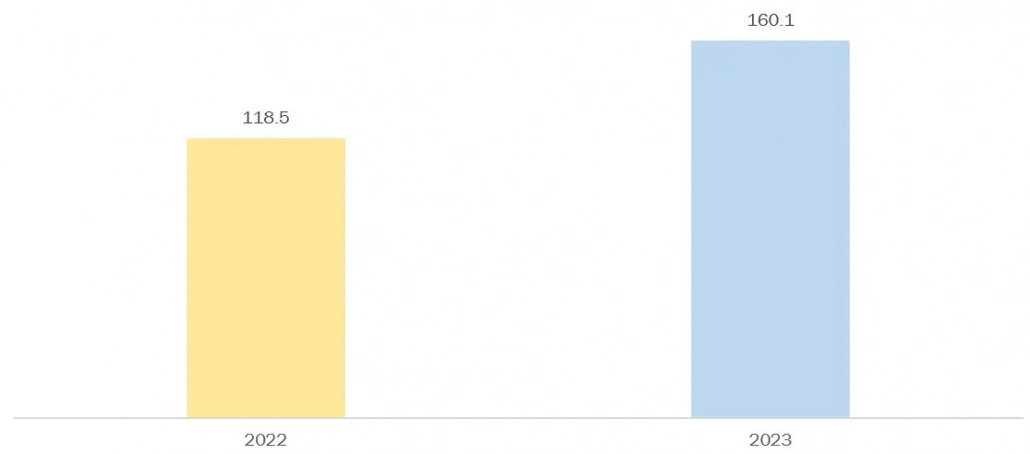WLAN Controllers: Centralizing Wireless Network Management and Security
A wireless local area network WLAN controller is a network equipment for managing several access points under it. It performs this task especially so as to ensure the appropriate configuration as well as running of each of these access points towards an effective wireless network operation. The WLAN controller market is expanding primarily due to the growing enterprise adoption of remote workspaces and the increasing demand for wireless connectivity. Additionally, the expanding BYOD strategy trend and the security issues affecting different businesses are driving the market’s expansion.
The network is utilized by government organizations, small and medium-sized enterprises (SMEs) from a range of industries, and households. With WLAN, the limitations of a wired network are eliminated since numerous devices can connect over great distances. It enables users to access apps and data from a distance. Additionally, WLAN guarantees increased bandwidth, which enhances network functionality. There is a range of 1 to 600 Mbps for data transmission. Authorized guest WLAN and internal WLAN are the two types of WLAN implementations.
Further, on order to safeguard the network and its users, WLAN controllers assist in enforcing security regulations, encryption standards, and access controls. The market for WLAN controllers is anticipated to grow in the upcoming years as a result of the increasing prevalence of cyberthreats and attacks, which continue to make network security a primary concern. For instance, according to the UK government’s Cyber Security Reaches Survey 2022, 39% of UK businesses reported experiencing a cyber attack in 2022, with phishing attempts accounting for the majority of cyber threats (83%) among the identified threats.
Global Adoption Trends
Centralization of WLAN controllers simplifies the network configuration, maintenance, monitoring. One key feature is ensuring uniform security, QoS standards, and policies across all APs which enables better stability and safer networks. Standalone access points provide features such as automated RF management, reduced interference, smooth client roaming, and optimized traffic. Controllers provide in-depth analytics on network performance for proactive management and optimization. For instance, Cisco offers wireless controllers and access points to satisfy Wi-Fi requirements. People never had greater expectations for network security and speed due to increased mobility and the explosion of IoT devices. In high-density environments, Cisco access points and intelligent controllers offer superior radio frequency performance while adhering to the 802.11ax (Wi-Fi 6) and 802.11ac (Wi-Fi 5) wireless standards.
Enterorprise Use Case
During the forecast period, small and medium-sized enterprises are expected to record the highest growth rates with the proliferation of startups and new digital service providers being the main reasons for this. Additionally, big businesses are implementing cutting-edge WLAN solutions to provide quick internet access. Market participants are creating tailored WLAN solutions to satisfy big businesses’ demands for wireless connectivity. For instance, Wi-Fi and 5G solutions can access spectrum up to 7 GHz due to the radio frequency-based filter technology called ultraBAW, which is provided by Qualcomm Technologies, Inc. Sub-7 GHz spectrum access facilitates the coexistence of 5G and Wi-Fi in automotive, IoT, and industrial applications, resulting in improved indoor and outdoor performance and power efficiency for next-generation mobile devices, laptops, and other solutions.
Market Dynamics and Drivers
The need for data traffic has skyrocketed due to the expanding use of cloud-based applications. Businesses need dependable and quick internet access to ensure their operations function as more and more shift their apps to the cloud. Businesses can transfer data quickly and effectively thanks to enterprise WLAN solutions’ high-speed data transmission rates, which enable this connectivity.
Business internet is seeing a rise in data volume as more enterprises incorporate digital technologies into processes. For instance, by the end of 2023, the mean monthly mobile data usage shall achieve 56 GB on a worldwide scale from 21 GB.
Figure 1: Global Mobile Network Data Traffic, Eb Per Year, 2022 to 2023

Source: Ericsson
In addition, the rising number of devices linked to business networks has resulted in a significant increase in the demand for high-speed data in recent years. Employees now access company data and apps from a variety of devices, necessitating reliable and fast data transmission capabilities, which enterprise WLAN solutions can provide. Data sharing and transfer between standalone control systems and other devices—such as sensors, thermostats, and smart lighting fixtures—that require wireless LAN controllers for network management are now feasible thanks to the Internet of Things. An Internet-based server network that can handle, store, and process important sources of data regarding industrial performance and operations is what cloud computing is all about. Technological advancements are driving the need for wireless LAN controllers that can process large amounts of data and extract valuable insights.
Furthermore, a significant factor propelling the market’s expansion is the growing emphasis placed by organizations on developing a digital and wireless workplace within premise mobility. Additionally, the growing BYOD and digital transformation trends are prompting businesses to think about expanding their enterprise campuses, which will support the market’s expansion in the upcoming year.
Key Developments
- In September 2023, Huawei announced the launch of three Product Portfolios for the Commercial Market to Build High-Quality Connections, including the Huawei Zero-Roaming Distributed Wi-Fi solution, the Huawei High-Quality Simplified Data Center Network Solution, and the High-Quality SME Office, in recognition of the large number of SMEs that contribute to economic development. To assist partners in gaining more clients and prospering in the commercial market, Huawei will create a wider range of products and services that are more marketed. A special experience assurance card is included with the Huawei CloudEngine S8700 to ensure excellent voice and video quality. It preferentially guarantees important voice and video conferences held by small and medium-sized businesses (SMEs) in real time. This guarantees seamless video conferences with a live experience for up to 10,000 users.
- In October 2022, At the India Mobile Congress, IO by HFCL unveiled the two new devices (indoor and outdoor versions) and introduced the Wi-Fi 7 enterprise-grade Wi-Fi access points. The new access points run Qualcomm’s Networking Pro platform and are optimized for open-source networking. They are also prepared for OpenWiFi.
In conclusion, the maintenance and operation of WLAN could be problematic especially so in large scale situations as with universities’ premises, private companies’ offices and even public internet access points. Specialized knowledge and tools are needed to ensure optimal performance, troubleshoot connectivity issues, and manage security policies. However, advanced WLAN solutions that support many simultaneous connections, low latency, and high data throughput are required by the expanding IoT ecosystem.
| Subscribe Us |



